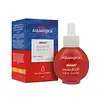What's inside
What's inside
 Key Ingredients
Key Ingredients

 Benefits
Benefits

 Concerns
Concerns

 Ingredients Side-by-side
Ingredients Side-by-side

Water
Skin ConditioningGlycerin
HumectantGlycolic Acid
BufferingLactic Acid
BufferingBetaine
HumectantPropylene Glycol
HumectantStomach Extract
HumectantPhenoxyethanol
PreservativeHydroxyethylcellulose
Emulsion StabilisingHyaluronic Acid
HumectantCI 16255
Cosmetic ColorantCitric Acid
BufferingPPG-20 Methyl Glucose Ether
Skin ConditioningGlyceryl Glucoside
HumectantEthylhexylglycerin
Skin ConditioningCucumis Sativus Fruit Extract
EmollientDisodium EDTA
Allantoin
Skin ConditioningWater
Skin ConditioningPropylene Glycol
HumectantTerephthalylidene Dicamphor Sulfonic Acid
UV AbsorberButyl Methoxydibenzoylmethane
UV AbsorberIsododecane
EmollientGlycerin
HumectantPhenylbenzimidazole Sulfonic Acid
UV Absorber3-O-Ethyl Ascorbic Acid
Skin ConditioningTapioca Starch
Triethanolamine
BufferingCyclopentasiloxane
EmollientEthylhexyl Methoxycinnamate
UV AbsorberCaprylic/Capric Triglyceride
MaskingAmmonium Acryloyldimethyltaurate/Vp Copolymer
Terminalia Ferdinandiana Fruit Extract
AntioxidantHyaluronic Acid
HumectantLaminaria Digitata Extract
Skin ProtectingHydrogenated Lecithin
EmulsifyingCetyl-Pg Hydroxyethyl Palmitamide
Skin ConditioningCeramide EOP
Skin ConditioningCeramide Ng
Skin ConditioningCeramide NP
Skin ConditioningCeramide As
Skin ConditioningCeramide AP
Skin ConditioningCholesterol
Emollient1,2-Hexanediol
Skin ConditioningEthylhexyl Salicylate
UV AbsorberMethylene Bis-Benzotriazolyl Tetramethylbutylphenol
UV FilterDecyl Glucoside
CleansingXanthan Gum
EmulsifyingDicaprylyl Carbonate
EmollientDimethicone
EmollientGlyceryl Stearate
EmollientCetearyl Olivate
Sorbitan Olivate
EmulsifyingCetearyl Alcohol
EmollientCeteareth-20
CleansingPhenoxyethanol
PreservativeEthylhexylglycerin
Skin ConditioningXylitylglucoside
HumectantAnhydroxylitol
HumectantXylitol
HumectantPanthenol
Skin ConditioningSodium Polyacrylate
AbsorbentCapsicum Annuum Fruit Extract
AntimicrobialBiosaccharide Gum-4
Skin ConditioningChamomilla Recutita Extract
Skin ConditioningAllantoin
Skin ConditioningSodium Gluconate
Skin ConditioningBHT
AntioxidantZinc Oxide
Cosmetic ColorantWater, Propylene Glycol, Terephthalylidene Dicamphor Sulfonic Acid, Butyl Methoxydibenzoylmethane, Isododecane, Glycerin, Phenylbenzimidazole Sulfonic Acid, 3-O-Ethyl Ascorbic Acid, Tapioca Starch, Triethanolamine, Cyclopentasiloxane, Ethylhexyl Methoxycinnamate, Caprylic/Capric Triglyceride, Ammonium Acryloyldimethyltaurate/Vp Copolymer, Terminalia Ferdinandiana Fruit Extract, Hyaluronic Acid, Laminaria Digitata Extract, Hydrogenated Lecithin, Cetyl-Pg Hydroxyethyl Palmitamide, Ceramide EOP, Ceramide Ng, Ceramide NP, Ceramide As, Ceramide AP, Cholesterol, 1,2-Hexanediol, Ethylhexyl Salicylate, Methylene Bis-Benzotriazolyl Tetramethylbutylphenol, Decyl Glucoside, Xanthan Gum, Dicaprylyl Carbonate, Dimethicone, Glyceryl Stearate, Cetearyl Olivate, Sorbitan Olivate, Cetearyl Alcohol, Ceteareth-20, Phenoxyethanol, Ethylhexylglycerin, Xylitylglucoside, Anhydroxylitol, Xylitol, Panthenol, Sodium Polyacrylate, Capsicum Annuum Fruit Extract, Biosaccharide Gum-4, Chamomilla Recutita Extract, Allantoin, Sodium Gluconate, BHT, Zinc Oxide
 Reviews
Reviews

Ingredients Explained
These ingredients are found in both products.
Ingredients higher up in an ingredient list are typically present in a larger amount.
Allantoin is a soothing ingredient known for its protective and moisturizingg properties. Because of this, it is often added to products with strong active ingredients.
Studies show higher concentrations of this ingredient can promote wound healing.
Though it can be derived from the comfrey plant, allantoin is produced synthetically for cosmetic products to ensure purity.
Learn more about AllantoinEthylhexylglycerin (we can't pronounce this either) is commonly used as a preservative and skin softener. It is derived from glyceryl.
You might see Ethylhexylglycerin often paired with other preservatives such as phenoxyethanol. Ethylhexylglycerin has been found to increase the effectiveness of these other preservatives.
Glycerin is already naturally found in your skin. It helps moisturize and protect your skin.
A study from 2016 found glycerin to be more effective as a humectant than AHAs and hyaluronic acid.
As a humectant, it helps the skin stay hydrated by pulling moisture to your skin. The low molecular weight of glycerin allows it to pull moisture into the deeper layers of your skin.
Hydrated skin improves your skin barrier; Your skin barrier helps protect against irritants and bacteria.
Glycerin has also been found to have antimicrobial and antiviral properties. Due to these properties, glycerin is often used in wound and burn treatments.
In cosmetics, glycerin is usually derived from plants such as soybean or palm. However, it can also be sourced from animals, such as tallow or animal fat.
This ingredient is organic, colorless, odorless, and non-toxic.
Glycerin is the name for this ingredient in American English. British English uses Glycerol/Glycerine.
Learn more about GlycerinHyaluronic acid is naturally found in healthy skin. It is a humectant, meaning it draws moisture to your skin.
This ingredient helps hydrate, soothe, and protect the skin.
What makes hyaluronic acid so hydrating? It has the capacity to bind or hold large amounts of water.
Fun fact: It is already naturally found in our bodies, such as the fluids of our eyes and our joints.
Studies find this ingredient to have anti-inflammatory and anti-microbial properties. This can help speed up wound-healing.
Hyaluronic acid can be irritating if the molecule has a low-molecular weight, or if the molecules are small.
One study found low-molecular weight hyaluronic acid to be pro-inflammatory, meaning some people may experience irritation. This is because our bodies use hyaluronic acid in the wound-healing process to signal to our bodies, via irritation, that something needs healing.
The same study found high-molecular weight hyaluronic acid to be anti-inflammatory.
These are some other common types of Hyaluronic Acid:
Learn more about Hyaluronic AcidPhenoxyethanol is a preservative that has germicide, antimicrobial, and aromatic properties. Studies show that phenoxyethanol can prevent microbial growth. By itself, it has a scent that is similar to that of a rose.
It's often used in formulations along with Caprylyl Glycol to preserve the shelf life of products.
Propylene Glycol is an odorless, colorless liquid. As a humectant, it helps skin retain moisture. It also aids in delivering active ingredients.
Another role of this ingredient is preventing a product from melting or freezing. Propylene glycol also adds antimicrobrial properties to a product, elongating product lifespan.
This ingredient is considered an organic alcohol and commonly added into both cosmetics and foods.
Those with sensitive skin or conditions may develop a rash when using this ingredient.
Learn more about Propylene GlycolWater. It's the most common cosmetic ingredient of all. You'll usually see it at the top of ingredient lists, meaning that it makes up the largest part of the product.
So why is it so popular? Water most often acts as a solvent - this means that it helps dissolve other ingredients into the formulation.
You'll also recognize water as that liquid we all need to stay alive. If you see this, drink a glass of water. Stay hydrated!
Learn more about Water